 W
WAustria-Hungary, often referred to as the Austro-Hungarian Empire or the Dual Monarchy, was a constitutional monarchy and great power in Central Europe between 1867 and 1918. It was formed with the Austro-Hungarian Compromise of 1867, and was dissolved following its defeat in the First World War.
 W
WThe Central Powers, also Central Empires, consisting of Germany, Austria-Hungary, the Ottoman Empire and Bulgaria – hence also known as the Quadruple Alliance —was one of the two main coalitions that fought World War I (1914–18).
 W
WThe Armistice of Villa Giusti ended warfare between Italy and Austria-Hungary on the Italian Front during World War I. The armistice was signed on 3 November 1918 in the Villa Giusti, outside Padua in the Veneto, Northern Italy, and took effect 24 hours later.
 W
WThe assassination of Archduke Franz Ferdinand of Austria, heir presumptive to the Austro-Hungarian throne, and Franz Ferdinand's wife Sophie, Duchess of Hohenberg, occurred on 28 June 1914 in Sarajevo when they were mortally wounded by Gavrilo Princip. Princip was one of a group of six assassins also containing Muhamed Mehmedbašić, Vaso Čubrilović, Nedeljko Čabrinović, Cvjetko Popović and Trifun Grabež coordinated by Danilo Ilić, a Bosnian Serb and a member of the Black Hand secret society. The political objective of the assassination was to break off Austria-Hungary's South Slav provinces so they could be combined into a Yugoslavia. The conspirators' motives were consistent with the movement that later became known as Young Bosnia. The assassination led directly to World War I when Austria-Hungary subsequently issued an ultimatum to the Kingdom of Serbia, which was partially rejected. Austria-Hungary then declared war on Serbia, triggering actions leading to war between most European states.
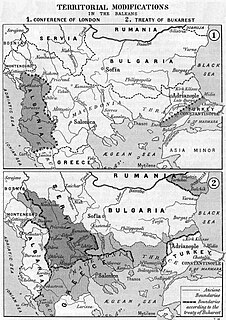 W
WThe Treaty of Bucharest was concluded on 10 August 1913, by the delegates of Bulgaria, Romania, Serbia, Montenegro and Greece. The Treaty was concluded in the aftermath of the Second Balkan War and amended the previous Treaty of London, which ended the First Balkan War. About one month later, the Bulgarians signed a separate border treaty with the Ottomans, who had regained some territory west of the Enos-Midia Line during the second war.
 W
WThe Treaty of Bucharest of 1916 was signed between Romania and the Entente Powers on 4 /17 August 1916 in Bucharest. The treaty stipulated the conditions under which Romania agreed to join the war on the side of the Entente, particularly territorial promises in Austria-Hungary. The signatories bound themselves to keep secret the contents of the treaty until a general peace was concluded.
 W
WThe Treaty of Bucharest (1918) was a peace treaty between Romania on the one side and the Central Powers on the other, following the stalemate reached after the campaign of 1917 left Romania isolated after Russia's unilateral exit from World War I.
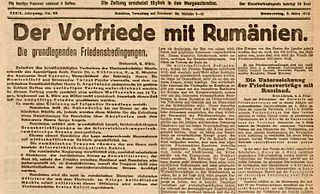 W
WThe Treaty of Buftea was a preliminary peace treaty between the Kingdom of Romania on one side and the Central Powers on the other.
 W
WCountess Lucy Christalnigg von und zu Gillitzstein, née Lucy Bellegarde, was born on 24 June 1872 in Klingenstein in the Kingdom of Württemberg, and died on 10 August 1914 in Srpenica, Slovenia. She was married to Count Oskar Christalnigg, a Slovenian patriot.
 W
WThe Triune Kingdom of Croatia, Slavonia and Dalmatia was part of Austria-Hungary during World War I. Its territory was administratively divided between the Austrian and Hungarian parts of the empire; Međimurje and Baranja were in the Hungarian part (Transleithania), the Kingdom of Croatia-Slavonia was a separate entity associated with the Hungarian Kingdom, Dalmatia and Istria were in the Austrian part (Cisleithania), while the town of Rijeka had semi-autonomous status.
 W
WThe Democratic Peasants' Party, also known as Democratic Party, Peasants' Party, National Democratic Party or Unirea Society, was a provincial party in Bukovina, Austria-Hungary, one of several groups claiming to represent the ethnic Romanians. It had a national liberal and left-wing populist agenda, and was mainly supported by "the peasants, the village teachers, and some of the intellectuals." Its leader was Aurel Onciul, seconded by Florea Lupu, both of whom were adversaries of the conservative and elitist Romanian National People's Party (PNPR). Rejecting sectarianism, the PȚD combined Austrian and Romanian nationalism, as Onciul argued that Romanian aspirations could only be fulfilled inside the multi-ethnic empire. For this reason, and for its role in dividing the Romanian vote, the party was often accused of double-dealing.
 W
WThe Eastern Front or Eastern Theater of World War I was a theater of operations that encompassed at its greatest extent the entire frontier between the Russian Empire and Romania on one side and the Austro-Hungarian Empire, Bulgaria, the Ottoman Empire and the German Empire on the other. It stretched from the Baltic Sea in the north to the Black Sea in the south, involved most of Eastern Europe, and stretched deep into Central Europe as well. The term contrasts with "Western Front", which was being fought in Belgium and France.
 W
WThe Battles of the Isonzo were a series of 12 battles between the Austro-Hungarian and Italian armies in World War I mostly on the territory of present-day Slovenia, and the remainder in Italy along the Isonzo River on the eastern sector of the Italian Front between June 1915 and November 1917.
 W
WThe Italian front or Alpine front involved a series of battles at the border between Austria-Hungary and Italy, fought between 1915 and 1918 in the course of World War I. Following secret promises made by the Allies in the 1915 Treaty of London, Italy entered the war aiming to annex the Austrian Littoral, northern Dalmatia, and the territories of present-day Trentino and South Tyrol. Although Italy had hoped to gain the territories with a surprise offensive, the front soon bogged down into trench warfare, similar to that on the Western Front in France, but at high altitudes and with very cold winters. Fighting along the front displaced much of the local population, and several thousand civilians died from malnutrition and illness in Italian and Austrian refugee-camps. The Allied victory at Vittorio Veneto in November 1918, the disintegration of Austria-Hungary and the Italian capture of Trento, Bolzano and Trieste ended the military operations. Italy also refers to the Great War as the "Fourth War of Independence", which completed the last stage of Italian unification.
 W
WThe Legione Redenta was an Italian military formation that participated in the Siberian intervention during the Russian Civil War. It was formed from 2500 prisoners of war who had been captured by the Russians from the Austro-Hungarian Army.
 W
WThe Lloyd 40.08 Luftkreuzer was a three engine triplane bomber type built during World War I. The design was proven to be ineffective and development did not proceed past the prototype stage.
 W
WMilitary cableways were used in the First World War by the Italy and Austria-Hungary to transport supplies up to their troops in mountain sectors of the front. Troops were often in high-altitude positions during the so-called “White War”, far removed from roads, mule tracks, pathways or existing cablecars. Moreover, where such infrastructure did exist, it generally followed the easiest routes and was therefore exposed to enemy fire. Providing the troops on the front line with a reliable supply of food and ammunition therefore often required the building of new infrastructure.
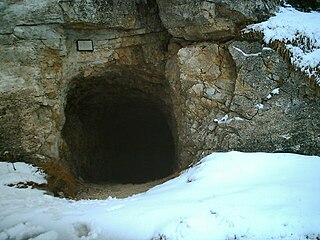 W
WThe mines on the Italian front during the First World War comprised a series of underground explosive charges of varying sizes, secretly planted between 1916 and 1918 by Austro-Hungarian and Italian tunneling units beneath their enemy's lines along the Italian front in the Dolomite section of the Alps.
 W
WNail Men or Men of Nails were a form of propaganda and fundraising for members of the armed forces and their dependents in the Austro-Hungarian Empire and the German Empire in World War I. They consisted of wooden statues into which nails were driven, either iron (black), or coloured silver or gold, in exchange for donations of different amounts. Some took different forms, including pillars, shields or local coats of arms and crosses, especially the Iron Cross, and in German there are a variety of alternate names for them, including Wehrmann in Eisen or eiserner Wehrmann, Nagelfigur, Nagelbild or Nagelbrett, Wehrschild and Kriegswahrzeichen. The most famous were the original Wehrmann in Eisen in Vienna and the 'Iron Hindenburg', a 12-metre (39 ft) statue of Hindenburg adjacent to the Victory Column in Berlin.
 W
WWhile Poland did not exist as an independent state during World War I, its geographical position between the fighting powers meant that much fighting and terrific human and material losses occurred on the Polish lands between 1914 and 1918.
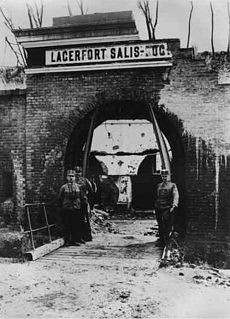 W
WPrzemyśl fortress was a series of fortifications constructed at Przemyśl by the Austro-Hungarian Empire from the mid 19th century until the First World War. It was constructed in sections, depending on the diplomatic relations between Austria and the Russian Empire, and saw extensive combat during World War I. Originally captured by the Russian Army, it was recaptured by the German Army in mid-1915. Afterwards the ruined fortifications lost their military significance.
 W
WThe Kingdom of Romania was neutral for the first two years of World War I, entering on the side of the Allied powers from 27 August 1916 until Central Power occupation led to the Treaty of Bucharest in May 1918, before reentering the war on 10 November 1918. It had the most significant oil fields in Europe, and Germany eagerly bought its petroleum, as well as food exports.
 W
WThe 1917 Romanian Campaign consisted in three battles between late July and early September 1917, fought between Germany and Austria-Hungary on one side and Romania and Russia on the other. Romania emerged from this campaign with a slight net territorial gain and won its most important battle during the First World War.
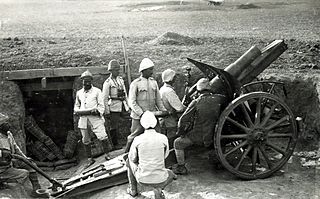 W
WThe Sinai and Palestine campaign of the Middle Eastern theatre of World War I was fought by the Arab Revolt and the British Empire, against the Ottoman Empire and its Imperial German allies. It started with an Ottoman attempt at raiding the Suez Canal in 1915, and ended with the Armistice of Mudros in 1918, leading to the cession of Ottoman Syria.
 W
WThe Sixtus Affair was a failed attempt by Emperor Charles I of Austria to conclude a separate peace with the allies in World War I. The affair was named after his brother-in-law and intermediary, Prince Sixtus of Bourbon-Parma.
 W
WThalerhof was an concentration camp created by the Austro-Hungarian authorities during 4.09.1914 — 10.05.1917, in a valley in foothills of the Alps, near Graz, the main city of the province of Styria
 W
WThe U-boat Campaign from 1914 to 1918 was the World War I naval campaign fought by German U-boats against the trade routes of the Allies. It took place largely in the seas around the British Isles and in the Mediterranean. The German Empire relied on imports for food and domestic food production and the United Kingdom relied heavily on imports to feed its population, and both required raw materials to supply their war industry; the powers aimed, therefore, to blockade one another. The British had the Royal Navy which was superior in numbers and could operate on most of the world's oceans because of the British Empire, whereas the Imperial German Navy surface fleet was mainly restricted to the German Bight, and used commerce raiders and unrestricted submarine warfare to operate elsewhere.
 W
WThe Ukrainian Austrian internment was part of the confinement of enemy aliens in Austria during World War I. Central Camp Talerhof was a concentration camp operated by the Austro-Hungarian imperial government between 1914 and 1917 in the Austrian state of Styria.
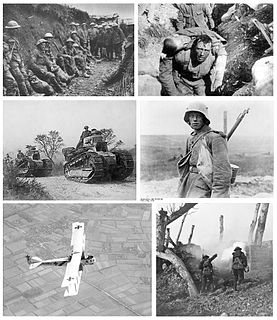 W
WThe Western Front was the main theatre of war during the First World War. Following the outbreak of war in August 1914, the German Army opened the Western Front by invading Luxembourg and Belgium, then gaining military control of important industrial regions in France. The German advance was halted with the Battle of the Marne. Following the Race to the Sea, both sides dug in along a meandering line of fortified trenches, stretching from the North Sea to the Swiss frontier with France, which changed little except during early 1917 and in 1918.
 W
WWhite Friday occurred during the Italian Front of World War I, when an avalanche struck an Austrian barracks on Mount Marmolada, killing 270 soldiers. Other avalanches the same day struck Italian and other Austrian positions, killing hundreds. According to some reports both sides deliberately fired shells into the weakened snowpacks in an attempt to bury the other side.
 W
W W
W W
W W
W W
W W
W W
W W
W W
W W
W W
W W
W